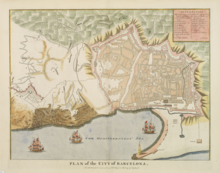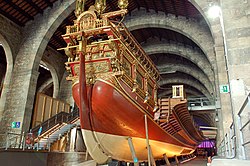
The Cathedral of the Holy Cross and Saint Eulalia, also known as Barcelona Cathedral, is the seat of the Archbishop of Barcelona in Catalonia, Spain. The cathedral was constructed from the thirteenth to fifteenth centuries, with the principal work done in the fourteenth century. The cloister, which encloses the Well of the Geese (Font de les Oques), was completed in 1448. In the late nineteenth century, the neo-Gothic façade was constructed over the nondescript exterior that was common to Catalan churches.
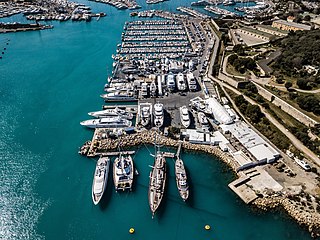
A shipyard, also called a dockyard or boatyard, is a place where ships are built and repaired. These can be yachts, military vessels, cruise liners or other cargo or passenger ships. Compared to shipyards, which are sometimes more involved with original construction, dockyards are sometimes more linked with maintenance and basing activities. The terms are routinely used interchangeably, in part because the evolution of dockyards and shipyards has often caused them to change or merge roles.

Ciutat Vella is a district of Barcelona, numbered District 1. The name means "old city" in Catalan and refers to the oldest neighborhoods in the city of Barcelona, Catalonia, Spain. Ciutat Vella is nestled between the Mediterranean Sea and the neighborhood called l'Eixample.

La Rambla is considered the most well known street in central Barcelona. A tree-lined pedestrian street, it stretches for 1.2 kilometres connecting the Plaça de Catalunya in its center with the Christopher Columbus Monument at Port Vell. La Rambla forms the boundary between the neighbourhoods of the Barri Gòtic to the east and the El Raval to the west.

The Gothic Quarter is the historic centre of the old city of Barcelona. It stretches from La Rambla to Via Laietana, and from the Mediterranean seafront to the Ronda de Sant Pere. It is a part of Ciutat Vella district.

Empordà is a natural and historical region of Catalonia, Spain, divided since 1936 into two comarques, Alt Empordà and Baix Empordà.

The Monastery of Santa Maria de Santes Creus, is a former Cistercian monastery in the municipality of Aiguamúrcia, Catalonia, Spain. The abbey was erected in the 12th century, in today's municipality of Aiguamúrcia, in the village of Santes Creus, in the province of Tarragona (Catalonia). However, it was in the thirteenth century when Peter III of Aragon expressed his desire to be buried in the monastery and a royal crypt was built for himself and his son, King James II that many of the local nobility established the custom to choose this place for burial. This led the monastery to increase in splendor and greatness thanks to the numerous donations received.

Vilafranca del Penedès, or simply Vilafranca, is the capital of Alt Penedès county in Penedès, Catalonia, Spain. It is situated in the Penedès Depression on the left bank of the Foix River, and on the main axis of communication from Barcelona to Tarragona and Valencia, served by a Rodalies Barcelona line 4 and by the AP-7 autopista as well as by the C-243 towards Sant Sadurní d'Anoia, and C-15 roads to Vilanova i la Geltrú and Igualada respectively.

La Rambla | Drassanes is a Barcelona Metro station located underneath Portal de la Santa Madrona, just off La Rambla in the Ciutat Vella district of Barcelona. It is named after the nearby Drassanes Reials de Barcelona, the old shipyards that are now the home of the Museu Marítim de Barcelona. It is the closest station to the Port of Barcelona and one of the network's closest stations to the sea, and is served by TMB-operated Barcelona Metro line L3.

The Reales Atarazanas is a waterside building that housed the shipyards, warehouses, customs house and tax offices of the old port of Santo Domingo, Dominican Republic. It was the property of the Spanish Crown. Begun in 1509, the Atarazanas is the oldest building of its type still standing in America, and one of a handful remaining in the Spanish world, amongst which are the Atarazanas Reales de Barcelona, in Barcelona, the Atarazanas Reales de Sevilla, in Seville, the Atarazanas del Grao in Valencia and the Royal Dockyard in Havana.

The Monastery of Pedralbes, otherwise the Royal Monastery of Santa Maria de Pedralbes is a Gothic monastery in Barcelona, Catalonia, Spain. It is now a museum, housing permanent exhibitions on its own art and legacy as well as third-party special exhibitions from time to time. The Chapel of St. Michael was restored and re-opened in 2018.

The Palau Reial Major is a complex of historic buildings located in Plaça del Rei, Barcelona, Catalonia, Spain. It was a residence of the counts of Barcelona and kings of Aragon. It is composed of three distinct edifices:
Catalan Gothic is an artistic style, with particular characteristics in the field of architecture. It occurred in the Principality of Catalonia within the Crown of Aragon between the 13th and 15th centuries, which places it at the end of the European Gothic period and at the beginning of the Renaissance. The term Catalan Gothic is confined to Barcelona and its area of influence, which has its own characteristics.

The July 1936 military uprising in Barcelona was a mutiny that occurred in Barcelona, the capital and largest city of Catalonia, in the Second Spanish Republic from 19 to 21 July 1936. It was one of the main events that marked the start of the Spanish Civil War.

The Seville Shipyard is a medieval shipyard in the city of Seville that operated from the 13th to the 15th century. Composed of seventeen naves, the building was connected to the Guadalquivir River by a stretch of sand.
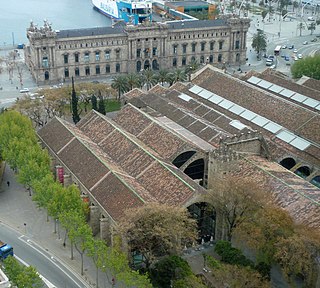
The Maritime Museum of Barcelona is located in the building of Drassanes Reials de Barcelona, the royal arsenal of Barcelona, dedicated to shipbuilding between the thirteenth century and eighteenth century. The first mention of these arsenals date from 1243 in a document indicating the boundaries of the city of Barcelona where it mentions its shipyard.
José María Martínez-Hidalgo y Terán was a Spanish sailor. He began his career in the Merchant Navy, later became an officer of the Spanish Navy and finally, in 1958, was appointed director of the Maritime Museum of Barcelona, a position he held until his retirement in 1983.

The Palau del Parlament de Catalunya is the seat of the Parliament of Catalonia, located in Barcelona. It was built between 1717 and 1727 as the arsenal of the Ciutadella, to the designs of Jorge Próspero de Verboom.

The Palace of the Viceroy was a palace in Barcelona, Catalonia, Spain. During the time it was a royal residence, it was known as the Royal Palace ), and its popular name was Hala dels Draps. It was located in the Pla de Palau, in the center of the Ciutat Vella district of Barcelona.
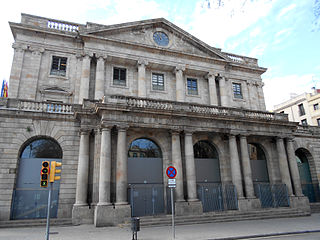
The Llotja de Barcelona or Llotja de Mar is a building located on Passeig d'Isabel II, in the La Ribera neighbourhood of Barcelona. The current 18th-century neoclassical building is considered one of the finest neoclassical building in Barcelona. Hidden within its walls, is the core of the original medieval llotja known as the saló de Contractacions, one of the finest civil gothic buildings in the Mediterranean. Originally conceived to provide merchants with a place for commercial transactions, it has also been used as a wheat store, an entertainment space, as a weapon magazine, a military barracks and the seat of the Consulate of the Sea and the Royal Barcelona Board of Trade. Today it houses the Cambra de Comerç and the Reial Acadèmia Catalana de Belles Arts de Sant Jordi.


